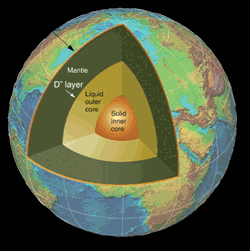Laboratory measurements of a high-pressure mineral believed to exist deep within the Earth show that the mineral may not, as geophysicists hoped, have the right properties to explain a mysterious layer lying just above the planet's core.
A team of scientists, led by Sébastien Merkel, of the University of California, Berkeley, now at CNRS and the University of Science and Technology of Lille, France, used beamline 16-ID-B of the High Pressure Collaborative Access Team facility at the Argonne Advanced Photon Source (APS) to conduct the first laboratory study of the deformation properties of a high-pressure silicate mineral called “post-perovskite.” The work appears in the June 22 issue of the journal Science.
The team included Allen McNamara of Arizona State University; Atsushi Kubo of the Consortium for Advanced Radiation Sources, University of Chicago; Thomas S. Duffy, Princeton University; Sergio Speziale, Lowell Miyagi and Hans-Rudolf Wenk, University of California, Berkeley (UCB); and Yue Meng, High Pressure Collaborative Access Team (HP-CAT), Carnegie Institution of Washington. With the integrated capability of x-ray diffraction and infrared laser heating of a diamond anvil cell established at 16-ID-B, the scientists synthesized the post-perovskite phase at pressure and temperature conditions exceeding 100 GPa and 2000K; x-ray diffraction patterns containing deformation information were collected in situ at high pressures. McNamara, a geophysicist, modeled the stresses the mineral would typically undergo as convection currents deep in Earth's mantle cause it to rise and sink.
"This is the first time the deformation properties of this mineral have been studied at lower mantle pressures," says McNamara. "The goal was to observe where the weak planes are in its crystal structure and how they are oriented." The results of the combined laboratory tests and computer models, he says, show that within the hypothesis of the study, post-perovskite doesn't fit one key parameter we know about the lower-mantle seismic anisotropy.
Earth's mantle is a layer that extends from the bottom of the crust, about 25 miles down, to the planet's core, 1,800 miles deep. Scientists divide the mantle into two layers separated by a wide transition zone centered around a depth of about 300 miles. The lower mantle lies below that zone.
Most of Earth's lower mantle is made of a magnesium silicate mineral called perovskite. In 2004, earth scientists discovered that under the conditions of the lower mantle, perovskite can change into a high-pressure form, which they dubbed post-perovskite. Since its discovery, post-perovskite has been geophysicists' favorite candidate to explain the composition of a mysterious layer that forms the bottom of Earth's lower mantle.
Known to earth scientists as D" (dee-double-prime), this layer averages 120-miles thick and lies directly above Earth's core. The D" layer was named in 1949 by seismologist Keith Bullen, who found the layer from the way earthquake waves travel through the planet's interior. But the nature of the D" layer has eluded scientists since Bullen's discovery.
"Our team found," says McNamara, "that while post-perovskite has some properties that fit what's known about D", our laboratory measurements and computer models show that post-perovskite doesn't fit one particular essential property." That property is seismic anisotropy, he says, referring to the fact that earthquake waves passing through the D" layer become distorted in a characteristic way.
McNamara explains, "Down in the D" layer, the horizontal part of earthquake waves travel faster than the vertical parts. But in our laboratory measurements and models, post-perovskite produces an opposite effect on the waves."
He adds, "This appears to be a basic contradiction."
McNamara notes that the laboratory measurements, made by team members at Princeton University; UCB; and the CNRS/ University of Science and Technology of Lille, France, were extremely difficult. They involved crushing tiny samples of perovskite on a diamond anvil until they changed into post-perovskite. Then the scientists, using the HP-CAT beamline, shot x-rays through the samples to identify the mineral crystals' internal structure.
This information was used by other team members at the University of California, Berkeley, to model how these crystals would deform as the mantle flows. The deformation results let the scientists predict how the crystals would affect seismic waves passing through them.
McNamara's work modeled the slow churn of the mantle, in which convection currents in the rock rise and fall about as fast as fingernails grow, roughly an inch a year. He calculated stresses, pressures and temperatures to draw a detailed picture of where post-perovskite would be found. This let him profile the structure of the D" layer.
"All these computations have been in two dimensions," he says. "Our next step is to go to 3-D modeling."
Does their work rule out post-perovskite to explain the D" layer? "Not completely," says McNamara. "We've begun to study this newly found mineral in the laboratory, but the work isn't yet over."
He adds, "It's possible that post-perovskite does exist in the lowermost mantle, and another mineral is causing the seismic anisotropy we see there."
Contact: S. Merkel [email protected]
See: Sébastien Merkel, Allen K. McNamara, Atsushi Kubo, Sergio Speziale, Lowell Miyagi, Yue Meng, Thomas S. Duffy, and Hans-Rudolf Wenk, “ Deformation of (Mg,Fe)SiO 3 Post-Perovskite and D'' Anisotropy,” Science 316 (5832), 1729 ( 22 June 2007). DOI: 10.1126/science.1140609
The original news release can be found at: https://clas.asu.edu/newsevents/newsreleases/2007/mcnamara_06212007.htm
French news release at the University of Lille:
This work was supported by NSF grants EAR-0510383 and EAR-0456356 (T.S.D., H.R.W., and A.K.M.) and the Carnegie/Department of Energy Alliance Center (T.S.D. and H.R.W.). Use of the HP-CAT facility was supported by the U.S. Department of Energy (DOE) Office of Basic Energy Sciences (BES), DOE National Nuclear Security Administration, NSF, Department of Defense (DOD) Tank-Automotive and Armaments Command, and the W. M. Keck Foundation. The APS is supported by DOE-BES under contract DE-AC02-06CH11357 . S.M. and S.S. also acknowledge support from the Miller Institute for Basic Research in Science.
Argonne is a U.S. Department of Energy laboratory managed by UChicago Argonne, LLC.

